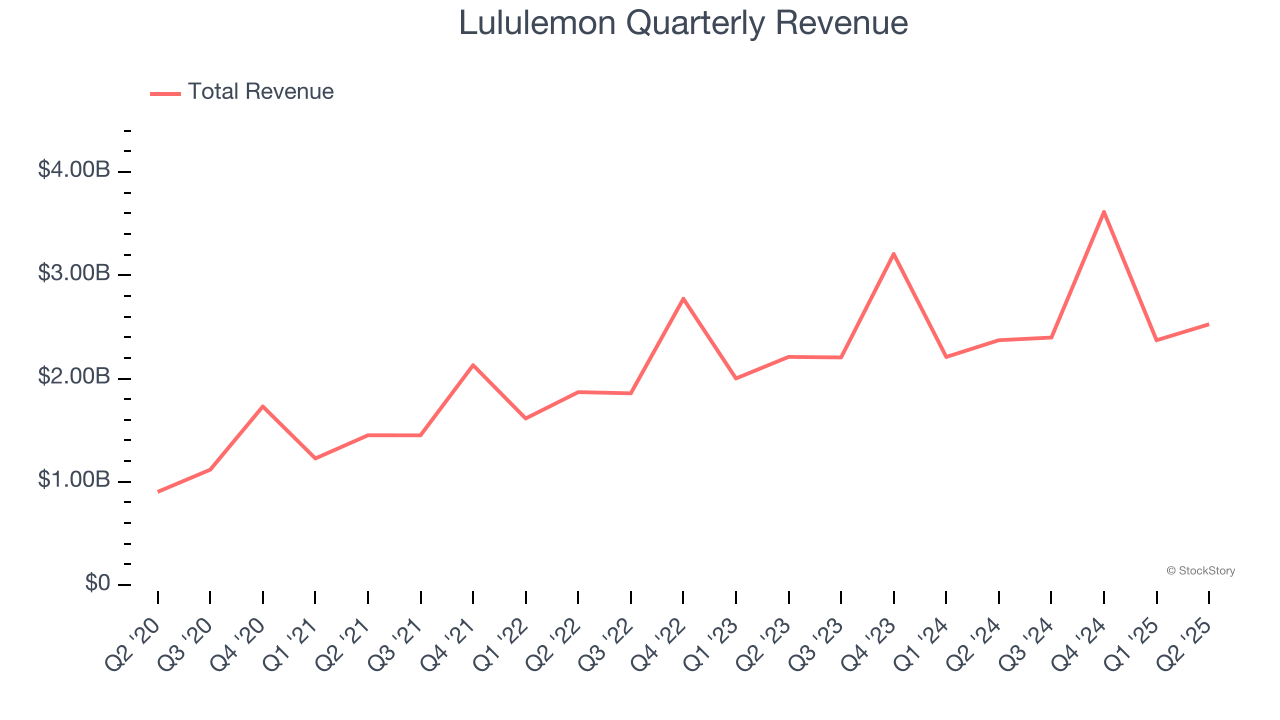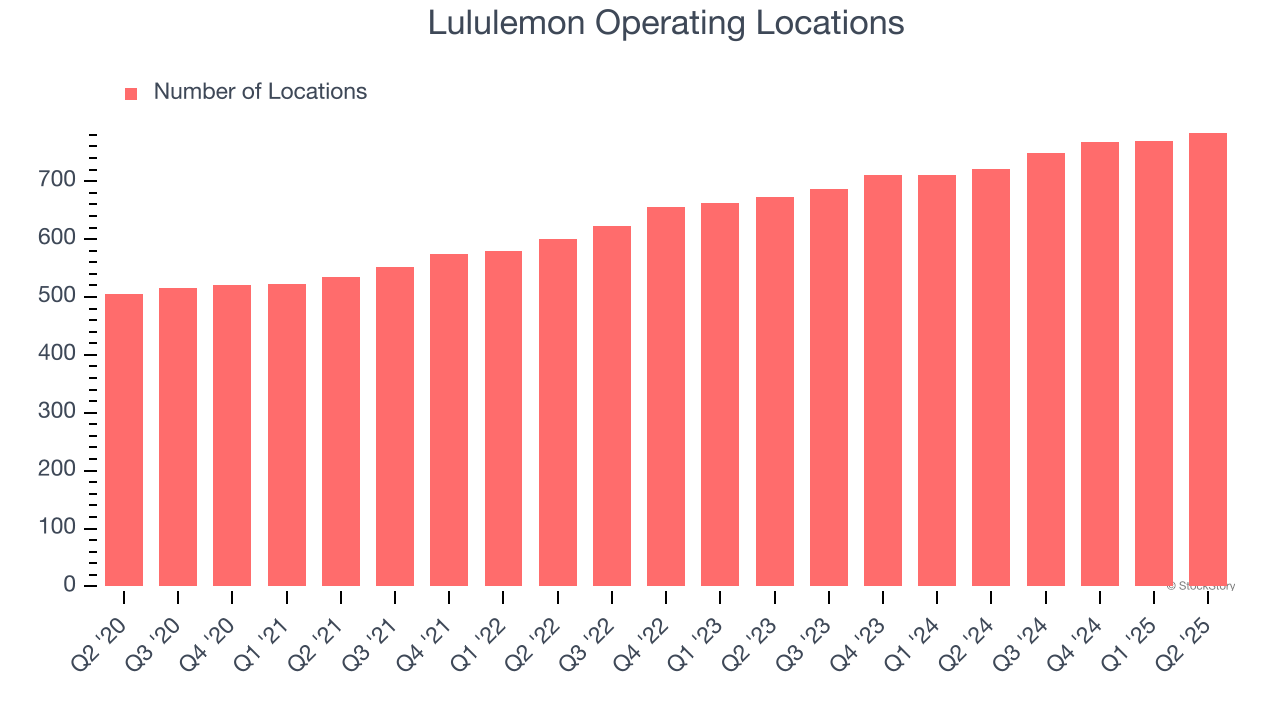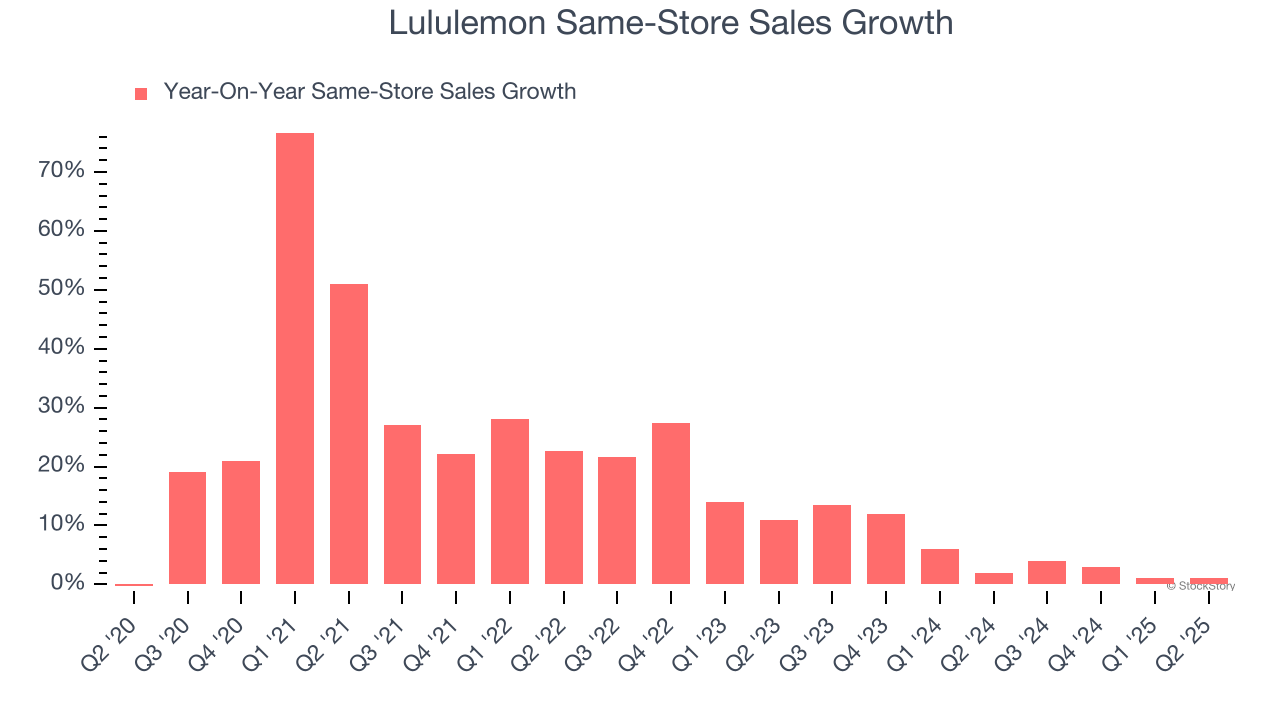
Athletic apparel retailer Lululemon (NASDAQ: LULU) missed Wall Street’s revenue expectations in Q2 CY2025, but sales rose 6.5% year on year to $2.53 billion. Next quarter’s revenue guidance of $2.49 billion underwhelmed, coming in 2.7% below analysts’ estimates. Its GAAP profit of $3.10 per share was 8.7% above analysts’ consensus estimates.
Is now the time to buy Lululemon? Find out by accessing our full research report, it’s free.
Lululemon (LULU) Q2 CY2025 Highlights:
- Revenue: $2.53 billion vs analyst estimates of $2.54 billion (6.5% year-on-year growth, 0.5% miss)
- EPS (GAAP): $3.10 vs analyst estimates of $2.85 (8.7% beat)
- The company dropped its revenue guidance for the full year to $10.93 billion at the midpoint from $11.23 billion, a 2.7% decrease
- EPS (GAAP) guidance for the full year is $12.87 at the midpoint, missing analyst estimates by 11.9%
- Operating Margin: 20.7%, down from 22.8% in the same quarter last year
- Locations: 784 at quarter end, up from 721 in the same quarter last year
- Same-Store Sales rose 1% year on year (2% in the same quarter last year)
- Market Capitalization: $23.76 billion
Company Overview
Originally serving yogis and hockey players, Lululemon (NASDAQ: LULU) is a designer, distributor, and retailer of athletic apparel for men and women.
Revenue Growth
A company’s long-term performance is an indicator of its overall quality. Any business can put up a good quarter or two, but many enduring ones grow for years.
With $10.9 billion in revenue over the past 12 months, Lululemon is a mid-sized retailer, which sometimes brings disadvantages compared to larger competitors benefiting from better economies of scale. On the bright side, it can still flex high growth rates because it’s working from a smaller revenue base.
As you can see below, Lululemon’s 20.4% annualized revenue growth over the last six years (we compare to 2019 to normalize for COVID-19 impacts) was exceptional as it opened new stores and increased sales at existing, established locations.

This quarter, Lululemon’s revenue grew by 6.5% year on year to $2.53 billion, missing Wall Street’s estimates. Company management is currently guiding for a 3.7% year-on-year increase in sales next quarter.
Looking further ahead, sell-side analysts expect revenue to grow 5.2% over the next 12 months, a deceleration versus the last six years. We still think its growth trajectory is attractive given its scale and indicates the market sees success for its products.
Here at StockStory, we certainly understand the potential of thematic investing. Diverse winners from Microsoft (MSFT) to Alphabet (GOOG), Coca-Cola (KO) to Monster Beverage (MNST) could all have been identified as promising growth stories with a megatrend driving the growth. So, in that spirit, we’ve identified a relatively under-the-radar profitable growth stock benefiting from the rise of AI, available to you FREE via this link.
Store Performance
Number of Stores
The number of stores a retailer operates is a critical driver of how quickly company-level sales can grow.
Lululemon operated 784 locations in the latest quarter. It has opened new stores at a rapid clip over the last two years, averaging 8.4% annual growth, much faster than the broader consumer retail sector. This gives it a chance to become a large, scaled business over time.
When a retailer opens new stores, it usually means it’s investing for growth because demand is greater than supply, especially in areas where consumers may not have a store within reasonable driving distance.

Same-Store Sales
The change in a company's store base only tells one side of the story. The other is the performance of its existing locations and e-commerce sales, which informs management teams whether they should expand or downsize their physical footprints. Same-store sales provides a deeper understanding of this issue because it measures organic growth at brick-and-mortar shops for at least a year.
Lululemon has been one of the most successful retailers over the last two years thanks to skyrocketing demand within its existing locations. On average, the company has posted exceptional year-on-year same-store sales growth of 5.3%. This performance suggests its rollout of new stores is beneficial for shareholders. We like this backdrop because it gives Lululemon multiple ways to win: revenue growth can come from new stores, e-commerce, or increased foot traffic and higher sales per customer at existing locations.

In the latest quarter, Lululemon’s same-store sales rose 1% year on year. This was a meaningful deceleration from its historical levels. We’ll be watching closely to see if Lululemon can reaccelerate growth.
Key Takeaways from Lululemon’s Q2 Results
It was encouraging to see Lululemon beat analysts’ gross margin expectations this quarter. We were also glad its EPS outperformed Wall Street’s estimates. On the other hand, its full-year EPS guidance missed and its EPS guidance for next quarter fell short of Wall Street’s estimates. Overall, this quarter could have been better. The stock traded down 12.9% to $179.50 immediately after reporting.
Lululemon underperformed this quarter, but does that create an opportunity to invest right now? The latest quarter does matter, but not nearly as much as longer-term fundamentals and valuation, when deciding if the stock is a buy. We cover that in our actionable full research report which you can read here, it’s free.





